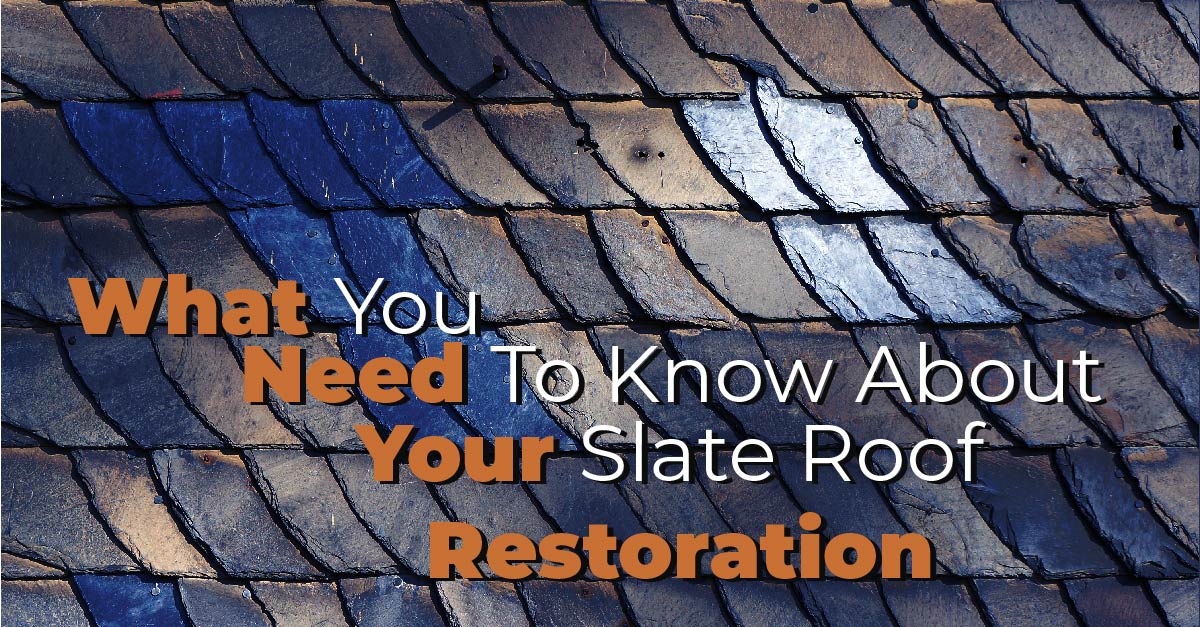What You Need To Know About Your Slate Roof Restoration

Slate roofing was traditionally the material of choice for high-value buildings. Many historical roofs on old churches and castles are made of slate as the primary material since it was the best material available at the time. Even today, many homeowners who want a premier roofing material which offers beauty, insulation value, longevity, and safety still choose slate. If you own a property with a slate roof, it’s important to learn when to consider repair, restoration, or replacement.
Reasons You May Need a Slate Roof Repair or Replacement
When you notice water damage to ceilings, it’s probably a sign your slate roof is leaking and causing damage inside your home. On the exterior, look for broken, slipped, or missing slates. Your contractor will carry out a thorough inspection to determine if repairs or complete replacement are in order. As a guide, if 20 percent of the original slates need to be replaced and repairs are scattered over multiple sections, further repair may not be cost-effective – you’ll need a complete slate roof replacement.
How Much Each Individual Slate Weighs
Slate is a very heavy roofing material and can only be installed on strong and structurally sound homes. Typically, a single slate tile which is a quarter-inch thick, one foot long, and six inches wide weighs about 1.74 pounds per tile. When you consider all the slate tiles your roof requires, it comes out to a huge amount of weight.
Square Footage of Roofing
Roof surfaces are typically measured in “squares.” A square is an area of a roof measuring 10 feet by 10 feet (equaling 100 square feet). To determine the total number of roofing squares on your roof, simply divide the total square feet by 100. For example, a roof with a total area of 24,000 square feet will have 240 squares (24,000 divided by 100).
Roofing Structures for Slate
With how heavy slate is, you need specially reinforced framing to support the weight. The first consideration to make when restoring a slate roof is the pitch of the roof, which should not be less than 4/12 (meaning 4 inches of rise for every 12 feet of run). If the roof is low-slope, you’ll need to rebuild your roof framing for a higher pitch.
The second important consideration is the weight of slate. Since slate is at least three times the weight of regular asphalt shingles, they require a stronger roof structure. Your existing roof framing will need to be reinforced (or rebuilt) to safely support the additional weight.
The Process of Slate Roof Restoration
Standard traditional roof framing is adequate to handle the weight of standard thickness slates (generally 3/16” to 1/4 inch thick). The common styles of slate roof construction include “stick build” and timber-framed styles with board decking (sheathing).
If you want to build a slate roof to last a century or two, stick to the tried and true traditional building styles. Your contractor should use full framing members, for instance, 2×8 or 2×10 rafters. Once the roofing structure, framing, and underlayment are installed, your contractor will carefully lay the slate tiles and properly nail them in place. Valleys, ridges, and flashing will also be installed to protect your home from any water infiltration.
How Long the Process Takes
A restored slate roof will completely transform the appearance of your home and add value to your house. When considering a slate roof restoration, you obviously want the project to be completed as soon as possible. But, how long will the roof restoration process really take?
When a slate roof expert comes to your home for the initial inspection, they will look at all the components of the project, including your existing roof structure and whether or not it will support the weight.
When your roofing contractor arrives to commence work, the first task is to remove the current roof and make the area completely ready for new slate tiles. If the existing structure is still pretty strong, this part of the process can be done faster. The installation process is what takes the bulk of the time since each slate must be handled with care and fitted delicately on the roof to prevent any cracking or chipping.
While most roofing contractors can finish the job in less than a week, the time it takes to restore a slate roof is dependent on numerous factors, including the size of the roof, pitch, shape, and the weather. Talk to your contractor to learn more about the expected timeline.
Bottom Line
Slate roof tiles may not be perfect for every homeowner, but they do offer a unique and exciting range of benefits. With proper maintenance, a slate roof can last more than a century. So, if you own a historic home with a slate roof, it’s important to work with an experienced roofer who understands this durable roofing material to restore it to its original state. Contact Steven’s Roofing in Norfolk, VA for all your slate roof maintenance and restoration needs!


